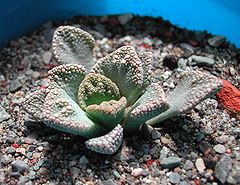Difference between revisions of "Titanopsis calcarea"
From Gardenology.org - Plant Encyclopedia and Gardening Wiki
Jump to navigationJump to search (Created page with '{{SPlantbox |familia=Aizoaceae |genus=Titanopsis |species=calcarea |Min ht box=1.8 |Min ht metric=cm |Max ht box=4 |Max ht metric=cm |height_ref=Flora - A Gardener's Encyclopedi…') |
|||
| Line 1: | Line 1: | ||
{{SPlantbox | {{SPlantbox | ||
|familia=Aizoaceae | |familia=Aizoaceae | ||
| − | |genus=Titanopsis | + | |genus=Titanopsis |
|species=calcarea | |species=calcarea | ||
| + | |habit=cacti-succulent | ||
| + | |habit_ref=Wikipedia | ||
|Min ht box=1.8 | |Min ht box=1.8 | ||
|Min ht metric=cm | |Min ht metric=cm | ||
| Line 11: | Line 13: | ||
|Max wd metric=cm | |Max wd metric=cm | ||
|width_ref=Flora - A Gardener's Encyclopedia | |width_ref=Flora - A Gardener's Encyclopedia | ||
| + | |origin=S Africa | ||
| + | |origin_ref=Wikipedia | ||
| + | |lifespan=perennial | ||
| + | |life_ref=Wikipedia | ||
|exposure=sun, part-sun | |exposure=sun, part-sun | ||
|sun_ref=Flora - A Gardener's Encyclopedia | |sun_ref=Flora - A Gardener's Encyclopedia | ||
| + | |water=dry, less when dormant | ||
| + | |water_ref=Wikipedia | ||
| + | |features=evergreen, flowers | ||
| + | |flower_season=late fall | ||
| + | |flower_ref=Wikipedia | ||
|flowers=orange, yellow | |flowers=orange, yellow | ||
|Temp Metric=°F | |Temp Metric=°F | ||
| Line 18: | Line 29: | ||
|usda_ref=Flora - A Gardener's Encyclopedia | |usda_ref=Flora - A Gardener's Encyclopedia | ||
|max_zone=10 | |max_zone=10 | ||
| − | |image= | + | |image=Titanopsis calcarea 1 IB.jpg |
|image_width=240 | |image_width=240 | ||
}} | }} | ||
| − | + | They are small plants, with [[Rosette (botany)|rosette]] up to 10 cm high. | |
| + | |||
| + | Leaves are up to 3 cm with truncate tip and rough little tubercles at the apex of the leaves. They look like limestone and are hard to be seen in the wild. | ||
| + | |||
| + | Yellow flowers with 2 cm diameter appear in late fall. | ||
==Cultivation== | ==Cultivation== | ||
| + | The plants are [[calcicole]] (=they appreciate calcaire soils) | ||
| + | |||
| + | The plants need well drained soil and sunny exposure. Few watering in summer and not at all in winter | ||
| + | |||
| + | Division of larger clumps is the easiest way of propagation. Seed is also possible. | ||
| + | Cultivation is difficult because they fear watering excess. | ||
===Propagation=== | ===Propagation=== | ||
Latest revision as of 15:51, 28 April 2010
| Habit | cacti-succulent
| |
|---|---|---|
| Height: | ⇕ | 1.8 cm"cm" can not be assigned to a declared number type with value 1.8. to 4 cm"cm" can not be assigned to a declared number type with value 4. |
| Width: | ⇔ | 50 cm"cm" can not be assigned to a declared number type with value 50. |
| Lifespan: | ⌛ | perennial |
| Origin: | ✈ | S Africa |
| Bloom: | ❀ | late fall |
| Exposure: | ☼ | sun, part-sun |
|---|---|---|
| Water: | ◍ | dry, less when dormant |
| Features: | ✓ | evergreen, flowers |
| USDA Zones: | 8 to 10 | |
| Flower features: | ❀ | orange, yellow |
|
calcarea > |
They are small plants, with rosette up to 10 cm high.
Leaves are up to 3 cm with truncate tip and rough little tubercles at the apex of the leaves. They look like limestone and are hard to be seen in the wild.
Yellow flowers with 2 cm diameter appear in late fall.
Cultivation
The plants are calcicole (=they appreciate calcaire soils)
The plants need well drained soil and sunny exposure. Few watering in summer and not at all in winter
Division of larger clumps is the easiest way of propagation. Seed is also possible.
Cultivation is difficult because they fear watering excess.
Propagation
Pests and diseases
Varieties
Gallery
References
External links
- w:Titanopsis calcarea. Some of the material on this page may be from Wikipedia, under the Creative Commons license.
- Titanopsis calcarea QR Code (Size 50, 100, 200, 500)

